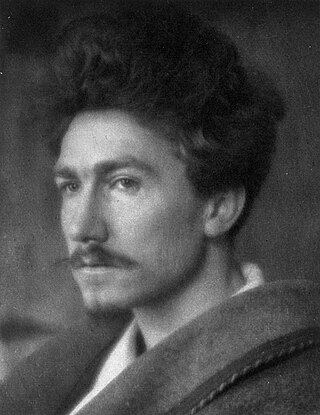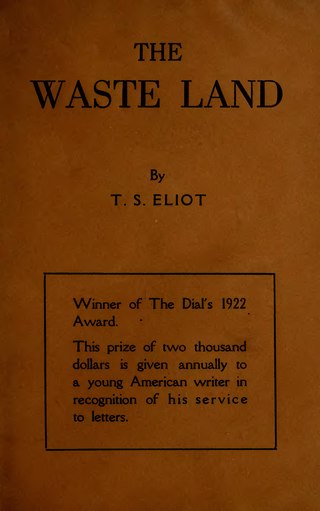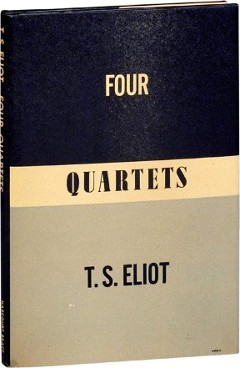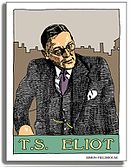Related Research Articles

Thomas Stearns Eliot was a poet, essayist, publisher, playwright, literary critic and editor. He is considered to be one of the 20th century's greatest poets, as well as a central figure in English-language Modernist poetry. His trials in language, writing style, and verse structure reinvigorated English poetry. He is also noted for his critical essays, which often reevaluated long-held cultural beliefs.

Ezra Weston Loomis Pound was an expatriate American poet and critic, a major figure in the early modernist poetry movement, and a collaborator in Fascist Italy and the Salò Republic during World War II. His works include Ripostes (1912), Hugh Selwyn Mauberley (1920), and his 800-page epic poem, The Cantos.

Arnaut Daniel was an Occitan troubadour of the 12th century, praised by Dante as "the best smith" and called a "grand master of love" by Petrarch. In the 20th century he was lauded by Ezra Pound in The Spirit of Romance (1910) as the greatest poet to have ever lived.

"The Love Song of J. Alfred Prufrock", commonly known as "Prufrock", is the first professionally published poem by American-born British poet T. S. Eliot (1888–1965). The poem relates the varying thoughts of its title character in a stream of consciousness. Eliot began writing "Prufrock" in February 1910, and it was first published in the June 1915 issue of Poetry: A Magazine of Verse at the instigation of fellow American expatriate Ezra Pound. It was later printed as part of a twelve-poem chapbook entitled Prufrock and Other Observations in 1917. At the time of its publication, "Prufrock" was considered outlandish, but the poem is now seen as heralding a paradigmatic shift in poetry from late 19th-century Romanticism and Georgian lyrics to Modernism.

"Journey of the Magi" is a 43-line poem written in 1927 by T. S. Eliot (1888–1965). It is one of five poems that Eliot contributed for a series of 38 pamphlets by several authors collectively titled the Ariel Poems and released by the British publishing house Faber and Gwyer. Published in August 1927, "Journey of the Magi" was the eighth in the series and was accompanied by illustrations drawn by American-born avant garde artist Edward McKnight Kauffer (1890–1954). The poems, including "Journey of the Magi", were later published in both editions of Eliot's collected poems in 1936 and 1963.

George Sutherland Fraser was a Scottish poet, literary critic and academic.

The Egoist was a London literary magazine published from 1914 to 1919, during which time it published important early modernist poetry and fiction. In its manifesto, it claimed to "recognise no taboos", and published a number of controversial works, such as parts of Ulysses. Today, it is considered "England's most important Modernist periodical."
Hugh Selwyn Mauberley (1920) is a long poem by Ezra Pound. It has been regarded as a turning point in Pound's career, and its completion was swiftly followed by his departure from England. The name "Selwyn" might have been an homage to Rhymers' Club member Selwyn Image. The name and personality of the titular subject are also reminiscent of T. S. Eliot's main character in "The Love Song of J. Alfred Prufrock".
James Longenbach was an American critic and poet. His early critical work focused on modernist poetry, namely that of Ezra Pound, W.B. Yeats, and Wallace Stevens, but came to include contemporary poetry as well. His book of criticism, The Resistance to Poetry, has been described as a "compact and exponentially provocative book." Longenbach published six volumes of poetry including Earthling (2017), which was a finalist for the National Book Critics Circle Award.
T. S. Eliot's Ariel poems are those written for Faber and Faber's series of Ariel Poems. All but "Triumphal March" also appear in his book Collected Poems: 1909–1962 under the heading Ariel Poems.
"Portrait of a Lady" is a poem by American-British poet T. S. Eliot (1888–1965), first published in September 1915 in Others: A Magazine of the New Verse. It was published again in March 1916 in Others: An Anthology of the New Verse, in February 1917 in The New Poetry: An Anthology, and finally in his 1917 collection of poems, Prufrock and Other Observations.

The Waste Land is a poem by T. S. Eliot, widely regarded as one of the most important English language poems of the 20th century and a central work of modernist poetry. Published in 1922, the 434-line poem first appeared in the United Kingdom in the October issue of Eliot's The Criterion and in the United States in the November issue of The Dial. It was published in book form in December 1922. Among its famous phrases are "April is the cruellest month", "I will show you fear in a handful of dust", "These fragments I have shored against my ruins" and the Sanskrit mantra "Datta, Dayadhvam, Damyata" and "Shantih shantih shantih".
East Coker is the second poem of T. S. Eliot's 1943 book Four Quartets. It was started as a way for Eliot to get back into writing poetry and was modelled after Burnt Norton. It was finished during early 1940 and printed in the UK in the Easter edition of the 1940 New English Weekly, and in the US in the May 1940 issue of Partisan Review. The title refers to a small community that was directly connected to Eliot's ancestry and was home to a church that was later to house Eliot's ashes.

The Dry Salvages is the third poem of T. S. Eliot's Four Quartets, marking the beginning of the point when the series was consciously being shaped as a set of four poems. It was written and published in 1941 during the air-raids on Great Britain, an event that threatened him while giving lectures in the area. The title comes from the name of a marine rock formation off the coast of Cape Ann, Massachusetts, where he spent time at as a child.

Four Quartets is a set of four poems written by T. S. Eliot that were published over a six-year period. The first poem, Burnt Norton, was published with a collection of his early works. After a few years, Eliot composed the other three poems, East Coker, The Dry Salvages, and Little Gidding, which were written during World War II and the air-raids on Great Britain. They were first published as a series by Faber and Faber in Great Britain between 1940 and 1942 towards the end of Eliot's poetic career. The poems were not collected until Eliot's New York publisher printed them together in 1943.

Burnt Norton is the first poem of T. S. Eliot's Four Quartets. He created it while working on his play Murder in the Cathedral, and it was first published in his Collected Poems 1909–1935 (1936). The poem's title refers to the manor house Eliot visited with Emily Hale in the Cotswolds. The manor's garden serves as an important image within the poem. Structurally, the poem is based on Eliot's The Waste Land, with passages of the poem related to those excised from Murder in the Cathedral.

"A Song for Simeon" is a 37-line poem written in 1928 by American-English poet T. S. Eliot (1888–1965). It is one of five poems that Eliot contributed to the Ariel Poems series of 38 pamphlets by several authors published by Faber and Gwyer. "A Song for Simeon" was the sixteenth in the series and included an illustration by avant garde artist Edward McKnight Kauffer. The poems, including "A Song for Simeon", were later published in both the 1936 and 1963 editions of Eliot's collected poems.

A Lume Spento is a 1908 poetry collection by Ezra Pound. Self-published in Venice, it was his first collection.
T. S. Eliot's 1915 poem "The Love Song of J. Alfred Prufrock" is often referenced in popular culture.
Persona poetry is poetry that is written from the perspective of a 'persona' that a poet creates, who is the speaker of the poem. Dramatic monologues are a type of persona poem, because "as they must create a character, necessarily create a persona".
References
- Bergonzi, Bernard. T. S. Eliot. New York: Macmillan Company, 1972.
- Childs, Donald J. and Eliot, T.S. Mystic, Son, and Lover. Continuum International Publishing Group (1997)
- Kirk, Russell. Eliot and His Age. Wilmington: ISA Books, 2008.
- David C. Martin (1 July 2003). Wilderness of Mirrors: Intrigue, Deception, and the Secrets that Destroyed Two of the Cold War's Most Important Agents. The Lyons Press. ISBN 1-58574-824-2.
- Montgomery, Marion. T. S. Eliot: An Essay on the American Magus. Athens: University of Georgia Press, 1970.
